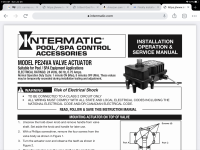Just thought I would share this in case anyone is looking for home made variable valve positioning.
My prior valve control was just 2 wall switches to control waterfall -> IFCS and skimmer -> mian drain Valves. That can be seen here.
 www.troublefreepool.com
www.troublefreepool.com
I have now installed 2 ewelink 4ch controllers with 6 relays that now let me control both of these - 3 way Valves and set them to any position. I can now use the wall switches or my phone to fully control the valve actuators.
The variable valve positioning is done by simply applying power to the actuator for a specific amount of time then removing the power once the valve is in the correct position. For example to set the valve to 50% I would apply power to the valve for 45 seconds to get into a fully opened position then apply power in the other direction for 20 seconds and then remove the power. This leaves the valve opened 50%.
This can be achieved bu using these..
Wich will allow you to use the inching function to activate the valve for a exact time frame. However this would mean using a relay for each required valve position as well as having to push a button to get to the fully opened position then wait the 45 seconds and push another button to open the valve to the required position.
I use a android automation app called 'Tasker' wich allows me full control over the ewelink devices. So I can set up my own routines in Tasker that will do all the automatic timing for me so I would not need to use the inching setting. This app will allow me to push 1 button on my phone and then have the relays put power to the valves for whatever timing I need for as many times as I needed.
My prior valve control was just 2 wall switches to control waterfall -> IFCS and skimmer -> mian drain Valves. That can be seen here.
Manual wall switches for actuators for unlimited flow control.
When we installed the pool I knew I would only have a few valves to control and figured I could just get a few actuators and wire them myself instead spending the big bucks on the automation. If I understand how the automation systems work they only allow for the 2 set points for a given valve...
I have now installed 2 ewelink 4ch controllers with 6 relays that now let me control both of these - 3 way Valves and set them to any position. I can now use the wall switches or my phone to fully control the valve actuators.
The variable valve positioning is done by simply applying power to the actuator for a specific amount of time then removing the power once the valve is in the correct position. For example to set the valve to 50% I would apply power to the valve for 45 seconds to get into a fully opened position then apply power in the other direction for 20 seconds and then remove the power. This leaves the valve opened 50%.
This can be achieved bu using these..
WIFI Momentary Inching Relay Self-locking Switch Module Wireless Relay Switch Module for Household Appliances, Compatible with Alexa Echo Google home, DC 7-32V DIY Switch Module for Garage Door Opener - - Amazon.com
WIFI Momentary Inching Relay Self-locking Switch Module Wireless Relay Switch Module for Household Appliances, Compatible with Alexa Echo Google home, DC 7-32V DIY Switch Module for Garage Door Opener - - Amazon.com
www.amazon.com
Wich will allow you to use the inching function to activate the valve for a exact time frame. However this would mean using a relay for each required valve position as well as having to push a button to get to the fully opened position then wait the 45 seconds and push another button to open the valve to the required position.
I use a android automation app called 'Tasker' wich allows me full control over the ewelink devices. So I can set up my own routines in Tasker that will do all the automatic timing for me so I would not need to use the inching setting. This app will allow me to push 1 button on my phone and then have the relays put power to the valves for whatever timing I need for as many times as I needed.




